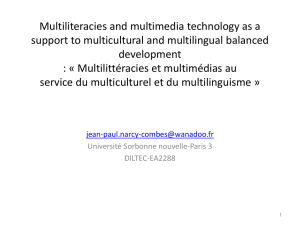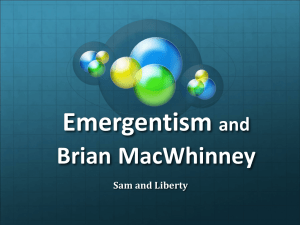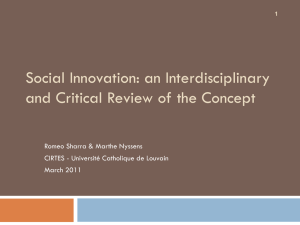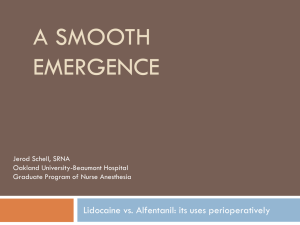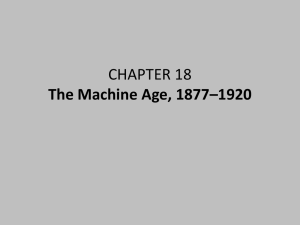Emergentist Approaches to Language
advertisement
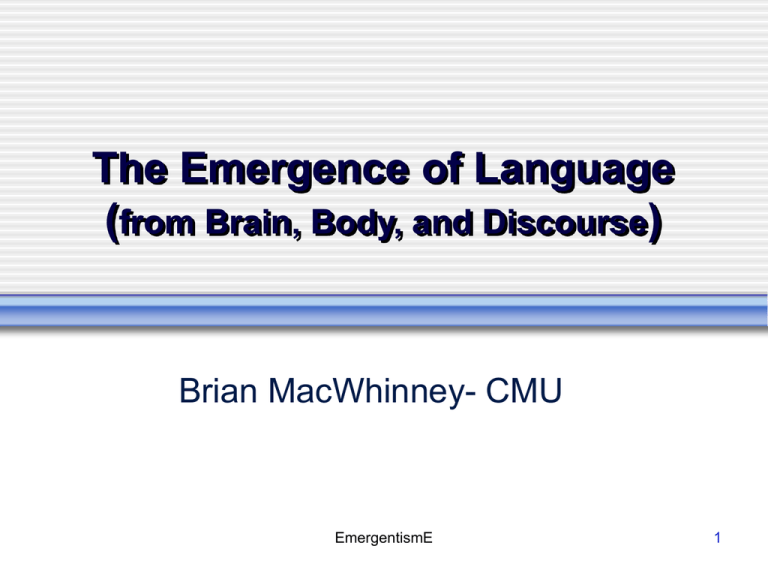
The Emergence of Language (from Brain, Body, and Discourse) Brian MacWhinney- CMU EmergentismE 1 The Special Gift Paradigm 1. 2. 3. 4. 5. 6. 7. Grammar Gene Speech is Special Modularity Critical Period* Poverty of the Stimulus* Sudden Evolution of Language* Centrality of Recursion* 2 Emergentism Genetic Locus? 3 Emergentism Cortical Module? 4 Emergentism Hard-wired modules? 5 Emergentism Speech is Special? 6 Emergentism Sudden evolution? • • • • • • • 7 MYA bipedalism 4 MYA tools, opposing thumb 3 MYA parietal expansion, TOM 1.5 MYA general cortical expansion .3 MYA expanding pulmonic support .1 MYA glottal control 30,000 creativity explosion 7 Emergentism Expiration of the Special Gift • Wild children are neurologically impaired • Newport and Johnson show no point of sudden loss • Recovery of language at 13 after hemispherectomy -- Vargha-Khadem • L2 age effects not unique to language learning-- ballet, golf, even math • Entrenchment account of L2 8 Emergentism Logical Problem? • Mothers speak grammatically - Newport • Degree-0 learnability - Lightfoot • Competition provides the negative evidence - MacWhinney • Error-free learning doesn’t occur - Pullum • The Stimulus isn’t impoverished after all 9 Emergentism Stipulation and the Gift • Rules have been the backbone of descriptive linguistics • Rules can be stipulated • Children learn rules - Brown, Marcus, Pinker 10 Emergentism Big Mean Rules 11 Emergentism Big Mean Flowcharts 12 Emergentism Changing theories … • • • • Rules are softening Evolution is stretching out Modularity is getting plastic Genome is becoming exaptive 13 Emergentism Kinder, gentler rules • Pinker (1984) add -ed • Aslin, Newport, Saffran (1999) golabu, pitaku • Marcus’s (2000) baby rules S -> A + B +A ga-ti-ga ga-na-ga ga-gi-ga ga-la-ga li-na-li li-ti-li li-gi-li li-la-li ni-gi-ni ni-ti-ni ni-na-ni ni-la-ni ta-la-ta ta-ti-ta ta-na-ta ta-gi-ta 14 Emergentism But … Lexicon, dialect, collocation, pragmatics, function, …. Core: X-bar, Merge, recursion Periphery 15 Emergentism Emergentism • Not: empiricism vs. nativism • Instead: emergentism vs. stipulationism 16 Emergentism Emergence vs stipulation 17 Emergentism Emergent structure in Honeycombs 18 Emergentism Emergent Columns Emergence of Oriented On-Off Neurons 19 Emergentism Emergent Computation 20 Emergentism Physical emergence Closures inhibit voicing Many languages lack /b/, few lack /p/ time 0 time 1 time 2 21 Emergentism Entrainment - Huygens 22 Emergentism Jaw entrains the glottis Lip-smacking rhythms (Macneilage & Davis, 2001) Thelen & Iverson, 1998 - jaw entrains glottis Hippocampal timers (Buzsáki 2004) Conversational synchrony (Wilson & Wilson 2005) 23 Emergentism Babbling entrains gesture • Iverson, Thelen • Central role of rhythm • Babbling and gesture both arise from Broca’s area • McNeill’s theory of growing points with gesture at the root of thought 24 Emergentism Dissipative Systems 25 Emergentism Catalysis 26 Emergentism Deformation 27 Emergentism Emergentist theory asks: • • • • • How did a structure emerge? Under what time-frame did it emerge? What dynamic processes are involved? How stable is the structure? How does removal of supports alter the emergence? 28 Emergentism Mechanisms of Emergence • • • • • • • • Entrainment, physical and social Adaptation, selection Competition, strength Hebbian learning, reinforcement Topology, short connections Self-organized criticality, catalysis Resonance Deformation, induction, regulation 29 Emergentism Why now? Without advanced methods, emergentist cognitive science was not possible • • • • • We didn’t have CHILDES, TalkBank Audio, video analysis was primitive - TalkBank We couldn’t simulate - PDP, SOM, ART We couldn’t image the brain - ERP, fMRI We couldn’t study learning in vivo - PSLC. With these advances, emergentism is becoming the default stance. 30 Emergentism Sources of emergence • Brain: Neural networks, short connections, area histology, spike propagation • Body: Embodied cognition, the vocal apparatus • Society: Discourse, roles, theory of mind 31 Emergentism Time-frames of Emergence 1. 2. 3. 4. 5. 6. Archaeogenetic Phylogenetic Embryological Developmental Online Diachronic 32 Emergentism Books The Emergence of Language Lawrence Erlbaum Associates, 1999 Elman, J. et al (1996) Rethinking Innateness MIT Press 33 Emergentism Examples 1. Morphological paradigms 2. From lexicon to syntax 3. Mutual exclusivity 4. Perspective flow 34 Emergentism 1. Neural Networks for Morphology unit s conn ec tio ns activ ations we ig hts lea rni ng rul e 35 Emergentism Summing activation z1 z2 y1 z3 y2 .54 .22 x1 x2 x3 36 Emergentism Neurons don’t send Morse code 37 Emergentism Memory molecules? Worm Runners Digest Training, grinding, feeding planaria 38 Emergentism The architecture OUTPUT UNITS der die das des dem den • • • • • • hidden 7 units 200 gender 20hidden 200 10 case units number units INPUT UNITS 143 phonological 5 semantic 168 Left-justified 17 case cues 11 phono 39 Emergentism Networks work • It worked -- it learned the input • It generalized as in German and English • It matched the developmental data 40 Emergentism With Limitations The homophony problem ringed -- rang -- wrung The masquerading morpheme problem -chen -en in Nacken, Hafen vs -en in Wissen The “underwent” problem Mutter should guarantee die Grossmutter The zero derivation problem schlagen should predict der Schlag The early “went” problem 41 Emergentism 2. The answer • Morphological learning must emerge from a lexical base • Therefore, we first have to simulate the learning of the lexicon 42 Emergentism Self-organizing lexical maps Li, Farkas, MacWhinney - Neural network - computer simulation - L1 lexical learning - CHILDES input - no initial organization - short connections Gradual Emergence 50, 150, 250, 500 words DevLex Model Bilingual self-organization Word Form Phonological Map Phonological ENGLISH PHONOLOGY Self-organization CHINESE PHONOLOGY Chinese Phonology ASSOCIATIVE CONNECTIONS (Hebbian learning) Word Meaning Co-occurrence-based representation (derived from separate component exposed to bilingual corpus) Self-organization CHCHINESE SEMANTICS Chinese Semantics ENGLISH SEMANTICS Semantic Map Refining competition Maps implement entrenchment • • Strong items dominate over weak. Late L2 items are parasitic on pre-existing L1 forms and maps Module Entrenchment Simultaneous Bilingualism LX LY balanced Successive Bilingualism L1 L2 dominates Parasitism and Transfer C L1 turtle L2 tortuga Entrenchment vs. Critical Periods • Critical Periods are linked to infancy. • Observed drop is not precipitous. • Lateralization is not linked to CP. • Language is not a unitary ability. • Golf, ballet are also age-related. • No mechanism has been discovered. • UG-related syntactic patterns are not strongly fossilized - Birdsong Entrenchment vs. Critical Periods • Critical Periods are linked to infancy. • Observed drop is not precipitous. • Lateralization is not linked to CP. • Language is not a unitary ability. • Golf, ballet are also age-related. • No mechanism has been discovered. • UG-related syntactic patterns are not strongly fossilized - Birdsong 5. Emergence from Resonance • Graduated interval recall • Multimodal consolidation • Self-organized criticality Graduated interval recall Pimsleur 67 Neural Basis Wittenburg et al. 2002 Optimization really helps Chinese Resonance Consolidation Circuits Dynamic Meaning Sound Consolidation Hippo campus Basal Ganglia Scaffold Consolidation and Time • Bones, muscles, cell walls, mitochondria, and immune system becomes stronger after periods of use and breakage. • These systems respond to pressures across time frames. (slow muscles, fast muscles) • Neurons work the same way. • They are sensitive to: one-trial learning (amygdalal input) local episodic learning (hippocampal input) embodied learning (self-motion) statistical learning (basal ganglia, circuits) strategic resonant learning (frontal input) Example 4: Perspective and grammar • Animal cognition is modular (bees) • Perspective integrates across modules • Language expresses perspective and changes in perspective 60 Emergentism Perspective unified image language as a functional neural circuit perspective direct experience perspective perspective deixis plans EmergentismE perspective roles 61 The dorsal and the ventral paths enactive depictive 62 Emergentism Mirror neurons -- Rizzolatti E grabs M grabs E with pliers M grabs 63 Emergentism Monkey grabbing in the dark 64 Emergentism Perspective shift (MacWhinney y Pléh (1987) SS: The dog that chased the cat bit the horse. # cambio 0 OS: The dog chased the cat that bit the horse. 1- OO: The dog chased the cat the horse bit. 1+ SO: The dog the cat chased bit the horse. 2 SS > OS = OO > SO The dog the cat the boy liked chased snarled. (dog -> cat -> boy -> cat -> dog) 4+ 65 Emergentism Ambiguity and perspective flow • John saw the Grand Canyon flying to New York. • The women discussed the dogs on the beach. • Although John always runs, a mile seems like a long distance to him. • I ordered her pancakes. • Visiting relatives can be a nuisance. • The horse raced past the barn fell. 66 Emergentism Constructions that mark perspective shift Passive Double Object Inverse Obviative Fictive agent Conflation Comparative Complementation Adverbalization Binding Dislocation Clefting Topicalización Possessive Ellipsis Coordination …. 67 Emergentism Other sample topics: the emergence of X from Y • • • • • CV syllable from lip-smacking Final devoicing from syllable structure Ergativity from subject omission Locatives from body parts Superordinates from most frequent subordinates • Use of Broca’s for ASL 68 Emergentism Getting it wrong QuickTime™ and a Motion JPEG A decompressor are needed to see this picture. 69 Emergentism Falsifiability of Emergentism? • Core claim : all processes arise from dynamic interactions • Core claim: Language arises from external pressures • Conceptualization cannot be falsified, but specific implementations can. • Specific implementations must be described mechanistically. This is really difficult. 70 Emergentism Summary • • • • Emergentism vs. Stipulationism Emergence on five time-frames Emergence from Brain, Body, and Society Four examples: morphology, syntax, ME, perspective • Emergentist accounts can be wrong. • But emergentism cannot be falsified, it can only be implemented. This is really difficult. 71 Emergentism Elman, J. (1990). Finding structure in time. Cognitive Science, 14, 179-212. Elman, J. L. (1999). The emergence of language: A conspiracy theory. In B. MacWhinney (Ed.), The emergence of language (pp. 1-28). Mahwah, NJ: Lawrence Erlbaum Associat Farkas, I., & Li, P. (2001). Modeling the development of lexicon with a growing self-organizing map. NIPS. Li, P., & MacWhinney, B. (1996). Cryptotype, overgeneralization, and competition: A connectionist model of learning of English reversive prefixes. Connection Science, 8, 3-30. MacWhinney, B. (1977). Starting points. Language, 53, 152-168. MacWhinney, B. (1978). The acquisition of morphophonology. Monographs of the Society for Research in C 43, Whole no. 1, pp. 1-123. MacWhinney, B. (1993a). Connections and symbols: Closing the gap. Cognition, 49, 291-296. MacWhinney, B. (1993b). Is there a logical problem of language acquisition? In C. Smith (Ed.), Early Cognition and the Transition to Language. Austin, TX: University of Texas Press. MacWhinney, B. (1999). The emergence of language from embodiment. In B. MacWhinney (Ed.), The emergence of language (pp. 213-256). Mahwah, NJ: Lawrence Erlbaum. MacWhinney, B. (2000). Lexicalist connectionism. In P. Broeder & J. Murre (Eds.), Models of language acquisition: Inductive and deductive approaches (pp. 9-32). Cambridge, MA: MIT Pre MacWhinney, B., & Leinbach, J. (1991). Implementations are not conceptualizations: Revising the verb learn Cognition, 29, 121-157. MacWhinney, B. J., Leinbach, J., Taraban, R., & McDonald, J. L. (1989). Language learning: Cues or rules? Journal of Memory and Language, 28, 255-277. Miikkulainen, R. (1993). Subsymbolic natural language processing. Cambridge, MA: MIT Press. Miikkulainen, R., & Mayberry, M. R. (1999). Disambiguation and grammar as emergent soft constraints. In B. MacWhinney (Ed.), The emergence of language (pp. 153-176). Mahwah, NJ: Lawrence Erlbaum As Rumelhart, D. E., & McClelland, J. L. (1986). On learning the past tense of English verbs. In J. L. McClelland & D. E. Rumelhart (Eds.), Parallel distributed processing: Explorations in the microstructure of cognition (pp. 216-271). Cambridge: MIT Press. 72 Emergentism
